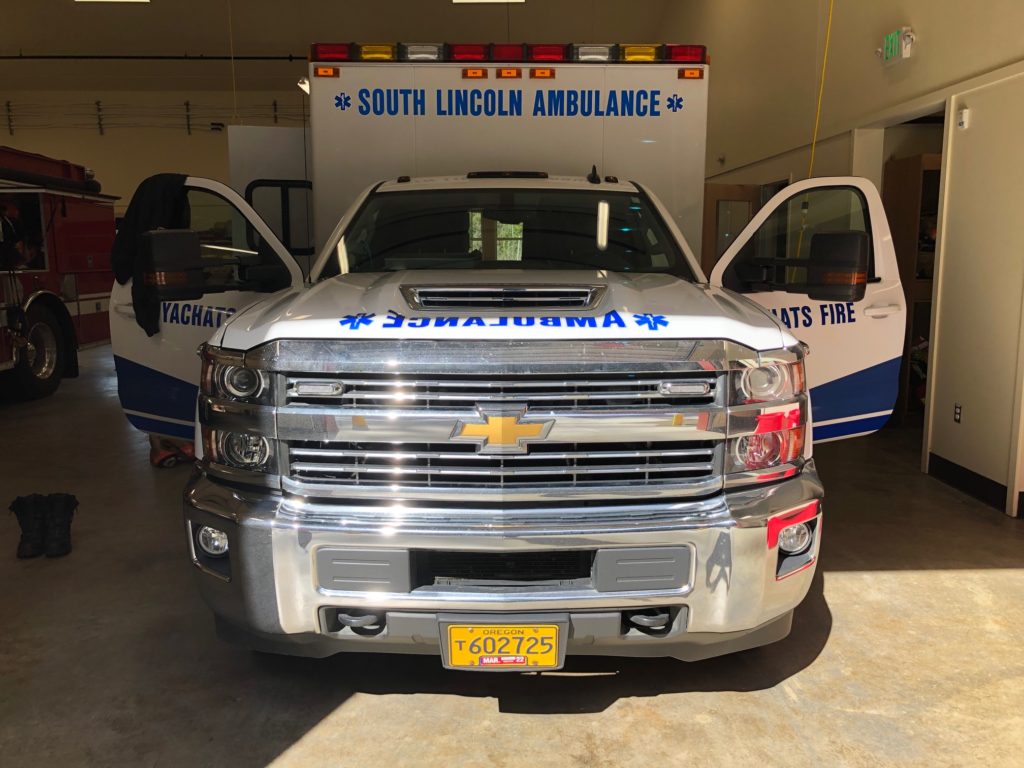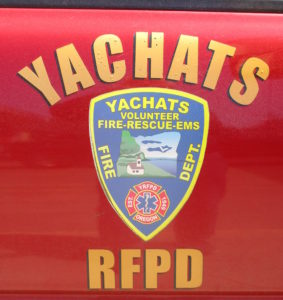
By QUINTON SMITH/YachatsNews.com
YACHATS – The board of the Yachats Rural Fire Protection District began gingerly discussing Monday how to approach a second attempt at a levy request in May following one soundly defeated by voters in November.
It may not go smoothly.
While voters previously approved levies when asked, the now-financially troubled district never asked for increases in either of its two levies since they started in 1998 and 2007. Meanwhile, the cost of personnel and equipment rose 4 percent to 12 percent a year.

After admitting publicly last fall it had not done a good job of managing its money or explaining its needs, voters soundly rejected a proposed operating levy 2-3 times the one it would replace. It was the first levy defeat in the district’s history.
To continue operating as it does now, the district needs to ask voters in May to approve a levy to support day-to-day operations. But the five-member board must meet a deadline of March 17 to tell county elections officials the amount it will seek.
The November request was for $1.59 per $1,000 assessed property value its first year, then dropping to an effective increase of $1 per $1,000 the second year after an existing levy of 59 cents per $1,000 expires. A 69 cent per $1,000 operating levy remains, as does a permanent tax base of 23 cents per $1,000. There is also voter-approved bond used to build its new fire station that carries a tax rate of 68 cents per $1,000 assessed property value – but that money can’t be used for day-to-day operations.
The board has yet to publicize or resolve three questions that its budget committee chair asked it to explain last June. Those are:
- What is it doing with the $338,000 in proceeds from the sale of its station in downtown Yachats;
- Explain the need for two administrators and the future of district leadership under 76-year-old Frankie Petrick, who has been a volunteer for 45 years, the volunteer fire chief for 18 years and lead administrator for 17;
- And, to clearly explain or resolve the relationship between the district and the private, non-profit ambulance service staffed by district firefighter/paramedics but controlled by Petrick, assistant administrator Shelby Knife, and three others. It is an arrangement like no other in Oregon.
Station cash into operations
One of those questions was answered Monday during the first of two scheduled board meetings this month to tackle the levy issue.

In a financial memo, Petrick said $338,000 in proceeds from the station’s sale was used to pay off a yearly bank loan the district had been using to help fund its operations from last February to November. Petrick also used property taxes it got in November to pay off a $54,000 lease on an engine.
That leaves the district with $445,000 cash on hand, she said, with another $46,000 in property taxes arriving by the time the 2021-22 fiscal year ends June 30.
With expenses averaging $92,000 a month, Petrick said “we will end our budget year with little to spare and will need to borrow $414,000 until taxes are received in November of 2022.”
Part of a new, larger tax levy is supposed to help the district avoid borrowing money each spring and summer only to use much of the property taxes it receives in November to pay it back – and then having to repeat that cycle.
Arguments over ambulance
The board has never discussed or explained its administrative makeup, but it did begin Monday – somewhat testily – trying to discuss South Lincoln Ambulance’s fees and its relationship with the fire district.
At least four board members have previously suggested discussing the district-ambulance relationship. But in the absence of stronger board leadership it has never been put on an agenda – which Petrick herself draws up.
Two newer board members – Drew Tracy and Donald Tucker – have been pressing Petrick and Knife to better break out the type of calls firefighters respond to – fire, accidents, medical calls, and the like. Some 75 percent of all calls for service involve the SLA ambulance.

Tracy, a former assistant police chief in Montgomery County, Md., said he had been researching what ambulance companies in Lane County and Pacific West Ambulance, which serves all of Lincoln County but the Yachats area, charge. South Lincoln’s $850 rate per call is half of what others charge, he said.
“Basically, we’re not – or you’re not – receiving money from insurance,” he told Petrick. “There’s an opportunity lost.”
Because of the low rates of Medicare or Medicaid reimbursements, Tracy said ambulance services in Lane County collect just 34 percent to 46 percent of what they bill.
“No fire and rescue department makes money running an ambulance service …” he said, a fact born out by the rest of Lincoln County’s cities or fire districts turning that job over to Pacific West. “In my opinion you should be billing appropriately like everyone else.”
He estimated if SLA billed the same as Pacific West, it would make $120,000 more a year – which could help fund one more district firefighter if there was a revenue sharing agreement. Now, the ambulance company pays $150 a month in rent and helps purchase some equipment in return for the district staffing its ambulance with two firefighter/paramedics or emergency medical technicians.
Petrick and board member Ed Hallahan pushed back, disputing Tracy’s figures and saying they didn’t believe there was a direct correlation between the amount SLA charged, the amount insurance pays and the amount it collects.
But Tucker, a former Tektronix executive and chair of the Southwest Lincoln County Water PUD, said he agreed with Tracy that South Lincoln is not charging enough.
“You’re losing insurance money that could be helping the district,” he said. “You’re using taxpayer money to run your ambulance service. I don’t want the ambulance service to go away … but to help us.”
When Tucker asked how the fire district board could see all of SLA’s finances, Petrick replied “file a public records request.”
At that point, Knife – the district’s administrative assistant who is also president of the SLA’s board — jumped in to say the discussion had veered off the topic of how to classify ambulance runs.
Extra meetings
The board is moving to two meetings a month – the next is Jan. 24 – so it can have more time to discuss how much money it should request in the proposed levy.
But Tucker suggested they don’t know why the November levy failed 56 percent to 44 percent and the board needed to better describe what would happen if the May levy is not passed.
There is also not a breakdown of expenses, revenue and any sort of long-range projection of the district’s financial needs. The only information it got Monday was Petrick’s memo saying the district would run out of money again and need to borrow.
Betty Johnson, who has been on the board for 15 years and has been acting as chair in the absence of Katherine Guenther, said she was unable to tell people “how we got here.”
“I can’t tell people what it was that put us in this position and why we need more money,” she said.
Petrick said if the district had asked for smaller but regular increases in its two levies the past 14 years, it wouldn’t be facing the need for a much larger one now.
“We should have done it sooner,” she said.
– – – – –



It failed because the mid to low income tax payers are tired of providing for everyone else when they can barely provide for their own. It’s like the old saying goes… “ You can’t squeeze blood from a turnip.” Yes charging more will amount to more revenue. How anyone can’t figure that one out is beyond me.
At this point I have the same low level of confidence in these fire people that I have in city government. A personnel shakeup is obviously needed – Petrick and others have simply been around too long and are now entrenched and inextricably immersed in some questionable situations. I’m irritated every time I drive by the new station, unquestioningly approved by gullible, well-meaning voters. Small town firepeople have a way of trying to build little fiefdoms with nobody typically daring to question anything. I’m thankful that we don’t have a police department – what a horror show that would be.